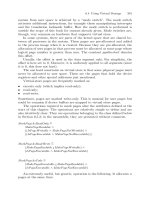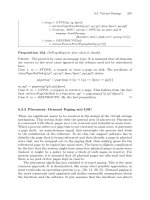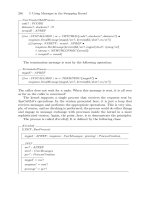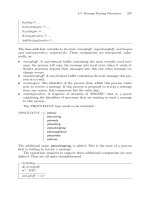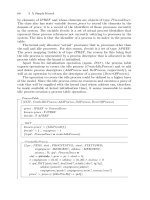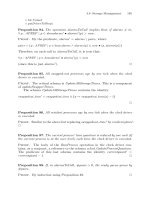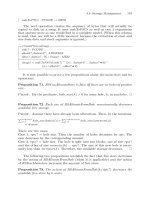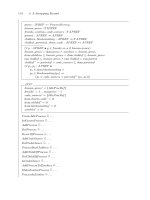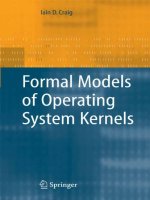Formal Models of Operating System Kernels phần 6 pptx
Bạn đang xem bản rút gọn của tài liệu. Xem và tải ngay bản đầy đủ của tài liệu tại đây (246.22 KB, 22 trang )
68 3 A Simple Kernel
by elements of IPREF and whose elements are objects of type ProcessDescr.
The class also has state variable known
procs to record the elements in the
domain of procs; it is a record of the identifiers of those processes currently
in the system. The variable freeids is a set of actual process identifiers that
represent those process references not currently referring to processes in the
system. The idea is that the identifier of a process is its index in the process
table.
The kernel only allocates “actual” processes; that is, processes other than
the null and idle processes. For this reason, freeids is a set of type APREF .
The procs mapping (table) is of type IPREF , the reason for this being that
the idle process is represented by a process descriptor that is allocated in the
process table when the kernel is initialised.
Apart from its initialisation operation (again, I
NIT ), the process table
exports operations to create the idle process (CreateIdleProcess) and to add
and delete process descriptors (AddProcess and DelProcess, respectively), as
well as an operation to return the descriptor of a process (DescrOfProcess).
The operation to create the idle process could be defined in a higher layer
of the model. Since the idle process owns no resources and executes a piece of
code that will be supplied with the kernel (and whose address can, therefore,
be made available at kernel initialisation time), it seems reasonable to make
idle process creation a process table operation.
ProcessTable
(INIT , CreateIdleProcess, AddProcess, DelProcess, DescrOfProcess)
procs : IPREF → ProcessDescr
known procs : F IPREF
freeids : F APREF
INIT
known procs
= {IdleProcRef }
freeids
=1 maxprocs − 1
(∃ ipd : ProcessDescr • createIdleProcess)
CreateIdleProcess
(∃ pr : PRIO; stat : PROCSTATUS; stwd : STATUSWD;
emptymem : MEMDESC; stkdesc : MEMDESC ;
memsz : N; ipd : ProcessDescr •
stat = pstready ∧ prio = pr ∧ stwd =0
s
∧ emptymem =(0, 0) ∧ stkdesc =(0, 20) ∧ memsz =0
∧ ipd.INIT [stat/stat?, knd/knd?, schdlv/slev ?, tq/tq?,
stkdesc/pstack?, emptymem/pdata?,
emptymem/pcode?, emptymem/mem?, memsz /msz?]
procs
= procs ⊕{IdleProcRef → ipd})
3.4 Basic Abstractions 69
AddProcess
∆(procs)
pid?:APREF
pd ?:ProcessDescr
procs
= procs ⊕{pid? → pd ?}
DelProcess
∆(procs)
pid?:APREF
procs
= {pid?}
−
procs
DescrOfProcess
pid?:IPREF
pd !:ProcessDescr
pd !=procs(pid?)
The Context class implements the context-switching operations. It is just
an encapsulation of the operations described in the previous chapter. It is, in
any case, relatively simple. The reader should note the comments in the class
definition. The operations defined in this class are extended by SwapIn and
SwapOut—they are defined for convenience.
Context
(INIT , SaveState, RestoreState, SwapIn, SwapOut)
ptab : ProcessTable
sched : LowLevelScheduler
hw : HardwareRegisters
INIT
ptb?:ProcessTable
shd?:LowLevelScheduler
hwregs?:HardwareRegisters
ptab
= ProcessTable
sched
= LowLevelScheduler
hw
= hwregs?
70 3 A Simple Kernel
SaveState
(∃ cp : IPREF •
sched.CurrentProcess[cp/cp!]
(∃ pd : ProcessDescr •
ptab.DescrOfProcess[cp/pid?, pd /pd !]
∧ (∃ regs : GENREGSET ; stk : PSTACK ; ip : N;
stat : STATUSWD •
hw.GetGPRegs[regs /regs !]
∧ hw.GetStackReg[stk/stk!]
∧ hw.GetIP[ip/ip!]
∧ hw.GetStatWd[stat/stwd!]
∧ pd .SetFullContext[regs /pregs?, ip/pip?, stat/pstatwd?,
stk/pstack ?])))
RestoreState
(∃ cp : IPREF •
sched.CurrentProcess[cp/cp!]
∧ (∃ pd : ProcessDescr •
ptab.DescrOfProcess[cp/pid?, pd /pd !]
∧ (∃ regs : GENREGSET ; stk : PSTACK ; ip : N;
stat : STATUSWD •
pd .FullContext[regs /pregs!, ip/pip!, stat/pstatwd!,
stk/pstack !]
∧ hw.SetGPRegs[regs /regs?]
∧ hw.SetStackReg[stk/stk?]
∧ hw.SetStatWd[stat/stwd?]
∧ hw.SetIP[ip/ip?])))
SwapOut =
(∃ cp : IPREF ; pd : ProcessDescr •
sched.CurrentProcess[cp/cp!]
∧ ptab.DescrOfProcess[pd /pd !]
∧ pd .SetProcessStatusToWaiting
∧ SaveState
o
9
sched.MakeUnready[currentp/pid?]
∧ sched.ScheduleNext)
SwapIn =
(∃ cp : IPREF ; pd : ProcessDescr •
sched.CurrentProcess[cp/cp!]
∧ pd .SetProcessStatusToRunning
∧ RestoreState)
SwitchContext = SwapOut
o
9
SwapIn
3.5 Priority Queue 71
3.5 Priority Queue
This kernel uses a priority queue as the core of its scheduler. The PRIO type
is equivalent to the integers, so the priorities cannot be arranged as broad
classes as they are in the kernel modelled in the next chapter (where there
are three priority classes, each modelled by a separate queue). This kernel
does not make assumptions about how the priority bands are defined, so
a representation has to be chosen to reflects this. The representation is a
sequence of process references.
Three relations are required for the definition of priorities. They are the
usual ≤, ≥ and = operations. The subscript is used just to differentiate them
from the corresponding relations over the integers.
≤
P
: PRIO ↔ PRIO
=
P
: PRIO ↔ PRIO
≥
P
: PRIO ↔ PRIO
∀ p
1
, p
2
: PRIO •
p
1
≤
P
p
2
⇔ p
1
≤ p
2
p
1
=
P
p
2
⇔ p
1
= p
2
p
1
≥
P
p
2
⇔ p
1
≥ p
2
The following derived relations are defined in the obvious fashion:
<
P
: PRIO ↔ PRIO
>
P
: PRIO ↔ PRIO
∀ p
1
, p
2
: PRIO •
p
1
<
P
p
2
⇔ (p
1
≤
P
p
2
) ∧¬(p
1
=
P
p
2
)
p
1
>
P
p
2
⇔ (p
1
≥
P
p
2
) ∧¬(p
1
=
P
p
2
)
For completeness, the definitions of these relations are given, even though they
should be obvious. Moreover, the <
P
relation is not used in this book.
A class defining the process priority queue (or queue of processes ordered
by priority) is as follows:
PROCPRIOQUEUE
(INIT , EnqueuePROCPRIOQUEUE,
NextFromPROCPRIOQUEUE, IsInPROCPRIOQUEUE,
IsEmptyPROCPRIOQUEUE, PrioOfProcInPROCPRIOQUEUE,
RemoveProcPrioQueueElem)
qprio : PREF → PRIO
procs :iseqPREF
dom qprio = ran procs
∀ p
1
, p
2
: PREF •
p
1
∈ ran procs ∧ p
2
∈ ran procs ∧ qprio(p
1
) ≤
P
qprio(p
2
) ⇒
(∃ i
1
, i
2
:1 #procs • i
1
≤ i
2
∧ procs(i
1
)=p
1
∧ procs(i
2
)=p
2
)
72 3 A Simple Kernel
INIT
PROCPRIOQUEUE
procs
=
EnqueuePROCPRIOQUEUE =
NextFromPROCPRIOQUEUE =
IsInPROCPRIOQUEUE =
IsEmptyPROCPRIOQUEUE =
PrioOfProcInPROCPRIOQUEUE =
RemovePrioQueueElem =
reorderProcPrioQueue =
The queue’s state consists of a finite mapping from process identifiers to their
associated priority (the priority mapping) and a queue of processes. The in-
variant states that if the priority of one process is less than that of another,
the first process should precede the second.
The class exports an initialisation operation (I
NIT ), an enqueue and re-
moval operations. There is an emptiness test and a test to determine whether
a given process is in the queue. A removal operation, as well as a reordering
operation, is also provided (the removal operation is used when re-prioritising
processes). The final operation that is exported returns the priority of a pro-
cess that is in the queue.
The reader will have noted that the priority record in the priority queue
duplicates that in the process table. What would happen in refinement is that
the two would be identified.
The enqueue operation is:
EnqueuePROCPRIOQUEUE
∆(qprio, procs)
pid?:PREF
pprio?:PRIO
qprio
= qprio ∪{pid? → pprio?}
(procs = ∧ procs
= pid?)
∨ (procs =
∧ ((qprio(pid?) ≤
P
qprio(head procs)) ∧ procs
= pid?
procs)
∨ ((qprio(pid?) >
P
qprio(last procs)) ∧ procs
= procs
pid?)
∨ (∃ s
1
, s
2
:iseqPREF | s
1
s
2
= procs •
((qprio(last s
1
) ≤
P
qprio(head s
2
)) ∧
procs
= s
1
pid?
s
2
)))
3.5 Priority Queue 73
The operation uses the priority of the process in determining where the process
is to be inserted in the queue. If the new process’ priority is greater (has a lower
value) than the first element of the queue, the new process is prepended to the
queue; conversely, if the priority is lower (has a greater value) than the last
element, it is appended to the queue. Otherwise, the priority is somewhere
between these two values and a search of the queue is performed (by the
existential quantifier) for the insertion point.
Proposition 21. The predicate of the EnqueuePROCPRIOQUEUE schema
satisfies the invariant of the PROCPRIOQUEUE schema that defines the
state.
Proof. Let I denote the invariant:
dom qprio = ran procs
∀ p
1
, p
2
: PREF •
p
1
∈ ran procs ∧ p
2
∈ ran procs ∧ qprio(p
1
) ≤
P
qprio(p
2
) ⇒
(∃ i
1
, i
2
:1 #procs •
i
1
≤ i
2
∧ procs(i
1
)=p
1
∧ procs(i
2
)=p
2
)
Case 1. procs = ∧ proc
= p⇒I .Sinceqprio(p) ≤
P
qpiro(p), for all p.
Clearly, in the case of procs
, i
1
≤ i
2
(since i
1
= i
2
).
Case 2. procs = .Letp
s
= {p : PREF | p ∈ ran procs
• qprio(p)}.There
are three cases to consider:
i. p is at the head of procs
—qprio(p) ≤
P
min p
s
;
ii. p is the last of procs
—qprio(p) >
P
max p
s
;
iii. p appears in the middle of the sequence—i.e., min p
s
≤
P
(p
q
prio(p) ≤
P
max p
s
.
Case 2i. Immediate.
Case 2ii. Immediate.
Case 2iii. Assume that there are two increasing sequences, s
1
and s
2
,ofPREF s
s.t. s
1
s
2
= procs. Then, if qprio(last s
1
) ≤
P
qprio(p) ≤
P
qprio(head s
2
),
procs
= s
1
p
s
2
. By induction, s
1
and s
2
satisfy I , therefore s
1
p
s
2
satisfies I . ✷
Proposition 22. If a process, p, has a priority, p
r
, such that, for any priority
queue, the value of p
r
is less than all of its elements, then p is the head of the
queue.
Proof. By the ordering ≤
P
, p
r
is less than all the elements of procs, i.e.,
p
r
≤
P
min p
s
,wherep
s
= {p : PREF | p ∈ ran procs • qprio(p)},asabove.
By the invariant, p
r
procs = procs
. ✷
74 3 A Simple Kernel
Proposition 23. If a process, p, has a priority, p
r
, such that, for any priority
queue, the value of p
r
is greater than all of its elements, then p is the last
element of the queue.
When a process has executed, the next element has to be selected from
the priority queue. The operation to do this is:
NextFromPROCPRIOQUEUE
∆(procs, qprio)
pid!:PREF
procs = pid!
procs
qprio
= {pid!}
−
qprio
Thepriorityisupdatedaswellasthesequenceofqueues.
Proposition 24. If an element, p, has been removed from a priority queue
and the priority of p is p
r
, then p
r
≤ head procs
.
Proof. If p
r
procs = procs
,thenp
r
> p
s
(where p
s
is as in Proposition
22). By the invariant, I ,
qprio(head procs) ≤
P
qprio(head(tail procs))
⇒ qprio(head(tail procs)) = min p
s
Therefore, qprio(head(tail procs)) ≥
P
qprio(head procs). ✷
The following pair of schemata define predicates. The first, IsInPROCPRI-
OQUEUE, determines whether the process, pid?, is in the queue of processes.
The second is true when the process queue is empty.
IsInPROCPRIOQUEUE
pid?:PREF
pid? ∈ ran procs
IsEmptyPROCPRIOQUEUE
procs =
The following schema defines an operation to return the priority of the
process denoted by pid?:
PrioOfProcInPROCPRIOQUEUE
pid?:PREF
pprio!:PRIO
pprio!=qprio(pid?)
3.5 Priority Queue 75
Proposition 25. For any pair of processes, p
1
and p
2
, that are both in the
same priority queue, if p
r,1
< p
r,2
(where p
r,i
denotes the priority of process
1 or 2), then p
1
occurs before p
2
in the queue; otherwise, the order in which
they occur is reversed.
Proof. This proposition is an immediate consequence of I . ✷
The unready operation, among others, requires that processes be removed
from the priority queue. The operation to do this is modelled by the following
schema:
RemovePrioQueueElem
∆(procs, qprio)
pid?:PREF
procs
= procs
−
{pid?}
qprio
= {pid?}
−
qprio
There is the case in which a process’ priority is re-calculated at some time.
Such a re-evaluation will affect the order in which the processes occur in the
queue. For the following, as for all process priority queue operations, it is
assumed that the priority value is established by a mechanism that is not
described by schemata in this section and that it is supplied to the operation
reordering the queue upon re-calculation.
It should be noted that the case in which more than one process’ priority is
re-calculated at a time does not cause any problems: if n processes have their
priority re-calculated, n iterations of the reorderProcPrioQueue are required.
Usually, however, re-calculations occur one at a time.
The following schema represents the desired operation:
reorderProcPrioQueue
=
RemovePrioQueueElem
o
9
EnqueuePROCPRIOQUEUE[newprio?/pprio?]
After substituting qprio
for qprio
in the appropriate places, this expands
into:
reorderProcPrioQueue
∆(procs, qprio)
pid?:PREF
newprio?:PRIO
∃ procs
:iseqPREF; qprio
: PREF → PRIO •
procs
= procs
−
{pid?}
∧ qprio
= {pid?}
−
qprio
∧ qprio
= qprio
∪{pid? → newprio?}
76 3 A Simple Kernel
∧ ((procs
= ∧procs
= pid?) ∨ (procs
=
∧ ((qprio
(pid?) ≤
P
qprio
(head procs
))
∧ procs
= pid?
procs
)
∨ ((qprio
(pid?) >
P
qprio
(last procs
))
∧ procs
= procs
pid)
∨ (∃ s
1
, s
2
:iseqPREF | s
1
s
2
= procs
•
(qprio
(last s
1
) ≤
P
qprio
(pid?) ≤
P
qprio
(head s
2
))
∧ procs
= s
1
pid?
s
2
)))
This operation must, clearly, respect PROCPRIOQUEUE’s invariant, so
we have the following:
Proposition 26. ReorderProcPrioQueue respects PROCPRIOQUEUE’s in-
variant.
Proof. By Proposition 21, EnqueuePROCPRIOQUEUE respects the invari-
ant. It remains, therefore, to show that ReorderProcPrioQueue does.
Recall that ReorderProcPrioQueue is defined as:
∆(procs, qprio)
p?:PREF
procs
= procs
−
{p?}
qprio
= {p?}
−
qprio
There are three cases to consider:
i. p?=head procs:thisisclear;
ii. p?=last procs:thisisclear;
iii. procs = s
1
p?
s
2
: this is proved by induction.
It is clear that the composition implies the invariant. ✷
Proposition 27. If a process, p, is removed from a priority queue, P, its
priority, p
r
, recalculated, and returned to P to form P
, then:
1. If the length of P is exactly 1, P
= P.
2. If the length of P is exactly 2, then p is either the first or last element of
P
.
Proof. There are two cases.
1. If p ∈ P and #P =1,thenP = p. This case is covered by Proposition
37 (first case).
2. If P = p
1
, p
2
, then it follows that if p = p
1
, p ≤
P
p
2
; otherwise, if p = p
2
,
p
1
≤
P
p. The result then follows by Proposition 21. ✷
3.6 Current Process and Prioritised Ready Queue 77
Proposition 28. If a process, p, is removed from a priority queue, P, its
priority, p
r
, recalculated and is reinserted into P to form P
, provided that P
has more than one element, exactly one of the following holds:
1. If the new value of p
r
is less than the old one, p will appear closer to the
head of P
than in P.
2. If the new value of p
r
is greater than the old one, p will appear closer to
the end of P
than P.
3. If the new value of p
r
is the same as the old one, one of the two previous
conditions will hold.
Proof. By Proposition 21. The interesting case is case 3, whose proof follows
from ≤
P
. ✷
Proposition 29. If a process, p, has priority, p
r
, is in a priority queue at
the nth position, if there are no processes of higher priority inserted into that
queue, and if the priority of p is not recomputed, process p will have the highest
priority after n processes have been removed from the queue.
Proof. This is just an instance of the corresponding proposition for FIFO
queues. ✷
Proposition 30. If a process, p, is at the nth position in a priority queue
and if m processes, each with priority higher than p, are added to the queue,
p will then occupy position n + m in the queue, provided that the priority of
p is not recomputed.
Proof. Let procs = s
1
p
s
2
with #s
1
= n. By Proposition 21 (case 2iii),
s
1
= s
1,1
s
m
s
1,2
,where#s
m
= m,ands
n
are sequences of new processes,
where s
=
s
1,1
s
1,2
. (More simply but less generally assume s
1
= s
1
s
m
.)
If #s
1
= n and #s
m
= m,ands
1
= s
1,1
s
1,2
and #s
1,1
+#s
1,2
= n,then
#(s
1,1
s
m
s
1,2
)=n + m.Sinceqprio(p) remains constant, the proposition
is proved. ✷
3.6 Current Process and Prioritised Ready Queue
This is just a redefinition of CURRENTPROCESS so that the ready is re-
placed by a priority queue. The result is still called CURRENTPROCESS.
Structural theorems carry over from PROCPRIOQUEUE.
The class CURRENTPROCESS represents the scheduler in this ker-
nel. The class contains a variable holding the currently executing process,
currentp, as well as the queue of ready processes (readyq, an instance of the
78 3 A Simple Kernel
PROCPRIOQUEUE class). The class exports two schemata that manipulate
currentp: CurrentProcess (which returns the value of currentp)andMake-
Current (which sets the value of currentp). The operation MakeReady adds a
process to the scheduler’s queue; to do this, the priority of the process must be
supplied. The ContinueCurrent is defined: it is, in fact, the identity relation
and serves only to continue the execution of the current process. The Suspend-
Current operation removes the currently executing process but does not swap
in another process. The schema for RunNextProcess defines an operation that
takes the next element from the ready queue, ready, and sets currentp so that
the new process can be executed. The operation defined by the schema called
SCHEDULENEXT is the primary interface to the scheduler.
Clearly, the scheduler needs to perform context operations. It is also clear
that it should use locking to ensure exclusive access to data structures.
CURRENTPROCESS
(INIT , CurrentProcess, MakeCurrent,
MakeReady, ContinueCurrent, SuspendCurrent,
RunNextProcess, SCHEDULENEXT )
currentp : PREF
readyqp : PROCPRIOQUEUE
ctxt : Context
lck : Lock
INIT
ct?:Context
lk?:Lock
readyqp.INIT
currentp
= NullProcRef
lck
= lk?
ctxt
= ct?
CurrentProcess =
MakeCurrent =
MakeReady =
MakeUnready =
isCurrentProc =
reloadCurrent =
ContinueCurrent =
SuspendCurrent =
RunNextProcess =
selectIdleProcess =
3.6 Current Process and Prioritised Ready Queue 79
SCHEDULENEXT =
CurrentProcess
cp!:PREF
cp!=currentp
MakeCurrent
∆(currentp)
pid?:PREF
currentp
= pid?
The MakeReady schema is defined as follows:
MakeReady =
(∃ pd : ProcessDescr •
ptab.DescrOfProcess[pd /pd !]
∧ pd .ProcessPriority[prio/prio!]
∧ pd .SetProcessStatusToReady
∧ readyq.EnqueuePROCPRIOQUEUE[prio/pprio?])
\ {prio}
The MakeReady operation inserts a new process into the queue. As can be
seen, the priority of the process must be used to compute the point where the
process is to be inserted.
As can be seen, ContinueCurrent is the identity:
reloadCurrent
currentp
= currentp
readyqp
= readyqp
ContinueCurrent =
reloadCurrent
∧ ctxt.RestoreState
The MakeUnready operation is defined as:
MakeUnready =
lck.Lock
o
9
((IsCurrentProc ∧
(ctxt.SaveState
o
9
RunNextProcess)
o
9
lck.Unlock)
∨ RemovePrioQueueElem)
o
9
lck.Unlock
80 3 A Simple Kernel
where:
isCurrentProc
ΞCURRENTPROCESS
p?:PREF
p?=currentp
This operation is used to remove a process from the readyq. It can be used,
for example, when a process has to wait on a device queue.
In this kernel, it is possible for a process to suspend itself. It does so by
calling the following operation:
SuspendCurrent =
lck.Lock
o
9
((ctxt.SaveState
∧ (∃ pd : ProcessDescr •
ptab.DesrcOfProcess[currentp/pid?, pd /pd !]
∧ ((pd .ProcessPriority[prio/prio!]
∧ pd .SetProcessStatusToWaiting)
∧ readyqp.EnqueuePROCPRIOQUEUE[currentp/x ?, prio/prio?])
\
{prio}))
o
9
RunNextProcess)
o
9
lck.Unlock
The RunNextProcess operation calls the scheduler and executes the next
process. Note that it assumes that the context of the previously executing
process has been saved before this operation executes.
RunNextProcess =
SCHEDULENEXT
o
9
ctxt.RestoreState
The primary interface to the scheduler is the following operation:
SCHEDULENEXT =
lck.Lock
o
9
((∃ pd : ProcessDescr •
ptab.DescrOfProcess[p/pid?, pd /pd !]
∧ (¬ readyqp.IsEmptyPROCPRIOQUEUE
∧ readyqp.NextFromPROCPRIOQUEUE[p/pid!]
∧ readyqp.MakeCurrent[p/pid?]
∧ pd .SetProcessStatusToRunning[p/pid?])
∨ selectIdleProcess))
o
9
lck.Unlock
The auxiliary operation, selectIdleProcess,isdefinedasfollows:
3.7 Messages and Semaphore Tables 81
selectIdleProcess
∆(currentp)
currentp
= IdleProcRef
This operation is required to ensure that the idle process runs when there is
nothing to execute in readyq.
Proposition 31. If currentp = p, for some process reference, p : APREF ,
then RunNextProcess implies that currentp
= p.
Proof. The proof divides into two cases.
Case 1. The ready queue is empty. Therefore, by SCHEDULENEXT :
readyqp.IsEmptyPROCPRIOQUEUE ∧ selectIdleProcess
and currentp
= IdleProcRef follows immediately.
Case 2. The ready queue is not empty. The following conjunction occurs in
the predicate of schema SCHEDULENEXT :
readyqp.NextFromPROCPRIOQUEUE ∧ readyqp.MakeCurrent[p/pid?]
The operation NextFromPROCPRIOQUEUE removes the first element from
the ready queue. This will, in general, be different from the current value of
currentp. ✷
3.7 Messages and Semaphore Tables
Semaphores have already been defined. This kernel also requires asynchronous
message queues (mailboxes), according to the requirements. This section con-
tains the outline specification for mailboxes.
First, the message type is defined. Messages are composed of data (mod-
elled by the atomic type MSGDATA) and a record of the message’s source
(MSGSRC ).
[MSGDATA]
A message can be sent by any “actual” process or by a hardware device.
MSGSRC == APREF ∪{hardware}
Putting these components together, we obtain MBOXMSG, the type of mes-
sages:
MBOXMSG == MSGSRC × MSGDATA
82 3 A Simple Kernel
The following (obvious) functions are defined to assist in manipulating mes-
sages:
msgsender : MBOXMSG → MSGSRC
msgdata : MBOXMSG → MSGDATA
∀ m : MBOXMSG •
msgsender(m)=fst m
msgdata(m)=snd m
The class that actually defines the mailbox type is as follows. The mailbox
is defined in the obvious way as a queue of messages.
The class exports operations to add a message (PostMessage) and obtain
the next message from the mailbox (NextMessage) and an operation that
determines whether there are messages in the mailbox (HaveMessages). The
initialisation operation just clears the queue of messages.
Mailbox
(INIT , PostMessage, HaveMessages, NextMessage)
msgs : QUEUE[MBOXMSG]
lck : Lock
INIT
l?:LOCK
msgs.INIT
lck
= l?
PostMessage
m?:MBOXMSG
lck.Lock
o
9
(msgs.Enqueue[m?/x ?]
o
9
lck.Unlock)
HaveMessages
lck.Lock
o
9
¬ msgs.IsEmpty
o
9
lck.Unlock
NextMessage
m!:MBOXMSG
lck.Lock
o
9
msgs.RemoveFirst[m!/x!]
o
9
lck.Unlock
Each process can have no more than one mailbox in this kernel (it does not
need more than one). This suggests that:
• An instance of GENTBL can be used to define and implement a central
table of mailboxes.
3.7 Messages and Semaphore Tables 83
• APREF can be used for the key type in this table.
The table type requires the following operations: initialise, create a mailbox
for a process, delete a process’ mailbox and retrieve the mailbox upon demand.
The type will have, in addition, to ensure mutual exclusion so that, should
two processes attempt, say, to create a mailbox at the same time, only one
will succeed.
The definition of the mailbox table is relatively simple and is, in any case,
similar to the SemaphoreTable type, which will be defined next.
Processes can also have one or more semaphores to provide synchronisation
on their shared data. The semaphore table contains all the semaphores in the
system that are available for use by processes. The table is an instance of the
generic GENTBL[K , D] class. Locking is used to ensure mutual exclusion.
The index type, SEMAID, is of little relevance. Processes will use values
of this type to refer to semaphores. It is defined as an atomic type:
[SEMAID]
Semaphore identifiers can be assumed to be generated by:
GenSemaId
sid!:SEMAID
An infinite number of semaphore identifiers is assumed. It is also assumed
that no identifier is generated twice.
SemaphoreTable
(INIT , NewSemaphore, DelSemaphore, GetSemaphore)
lck : Lock
stbl : GENTBL[SEMAID, Semaphore]
INIT
l?:Lock
lck
= l? ∧ stbl.INIT
NewSemaphore =
lck.Lock
o
9
(∃ s : Semaphore; sid : SEMAID •
s.INIT
∧ GenSemaId[sid /sid!]
∧ stbl.AddTBLEntry[sid /k?, s/d?]
o
9
lck.Unlock
84 3 A Simple Kernel
DelSemaphore = lck .Lock
o
9
stbl.DelTBLEntry[sid?/k?]
o
9
lck.Unlock
GetSemaphore = lck .Lock
o
9
stbl.GetTBLEntry[sid/k?, s!/d!]
o
9
lck.Unlock
3.8 Process Creation and Destruction
In this kernel, processes are created statically, assigned a static priority and
linked to the kernel. This has the implication that process creation and termi-
nation primitives are not really required. However, it is necessary to commu-
nicate some basic parameters about each process to the kernel. This can be
done using the following operations (defined, for convenience, inside an object
called UserLibrary).
The operations defined below should be easily understood: their names
state what they should do.
UserLibrary
(INIT , CreateProcess, TerminateProcess, Suspend)
procid : IPREF
ptab : ProcessTable
sched : Scheduler
INIT
ptb?:ProcessTable
schd?:Scheduler
ptab
= ptb?
sched
= schd?
CreateProcess
pprio?:PRIO
stkd?:PSTACK
datad?:PDATA
cdd ?:PCODE
allocin?:MEMDESC
totmemsz?:N
pid!:PREF
∃ pd : ProcessDescr; stat : PROCSTATUS | stat = pstnew •
pd .INIT [pprio?/pr?, stat/stat?, stkd?/pstack?,
datad?/pdata?, cdd ?/pcode ?, allocin?/mem?,
totmemsz?/msz?]
∧ ptab.AddProcess[pd /pd ?, pid!/p!] ∧ sched.MakeReady[pid!/pid?]
∧ procid
= pid!
3.9 Concluding Remarks 85
TerminateProcess =
sched.MakeUnready[procid/pid ?] ∧
ptab.DelProcess[procid/pid?]
Suspend = sched.SuspendCurrent
3.9 Concluding Remarks
The kernel modelled in this chapter is extremely simple. It is not so simple
that it cannot be used. Indeed, it is of a complexity not far from that of the
tiny kernels used for embedded and some real-time systems. The µC/OS [18]
is a good example of such a kernel.
The kernel is minimal in the sense that it contains no facilities for per-
forming device-specific operations and contains no clock process. If the kernel
were to be used in reality, these operations would have to be modelled and
implemented. This would not be a particularly difficult operation, for all the
necessary operations have been provided by the above model.
The kernel is also open as far as security is concerned. This is an area that
requires further development.
The above kernel is also a fairly static affair. Processes are statically linked
to the kernel via a library of routines (basically the interface routines and the
small library defined at the end of the last section). Processes are free to
change their priority and to create new processes when they are running but
this is subject to the constraint that all processes must always be resident in
main store.
Main store itself is partitioned statically as a configuration operation when
user code is linked to the kernel. There are no storage-management operations
in this kernel, so the process creation primitives are, really, of limited use.
Even though the kernel is so limited, it is reasonable useful. In the next
chapter, a larger kernel, one that can perform storage management (it per-
forms process swapping) is presented and discussed.
Perhaps the most significant aspect of this chapter’s model is that it acts
as an existence proof. It is possible to define a formal model of an operating
system kernel and to prove some of its properties. In the next chapter, the
model becomes more involved and more properties are proved. As noted in
the introduction, the general method of this book is to increase complexity
and to prove more properties (when appropriate) as the book progresses.
5
Using Messages in the Swapping Kernel
Hoc volo, sic iubeo, sit pro ratione voluntas
– Juvenal, Satires, 223
5.1 Introduction
The kernel that was the topic of the last chapter employed semaphores as
its inter-process communication primitive. In that kernel, semaphores were
used both to synchronise processes, as in the case of driver processes being
awakened by a semaphore shared with the corresponding ISR. Semaphores
were also used to synchronise processes that shared data; for example, the
clock driver and alarm requests.
Semaphores have, of course, a long and distinguished history, but they are
open to abuse. One must (almost) always ensure that the Wait and Signal
operations come in pairs. Sometimes, as was the case in the last chapter, the
two operations are applied to a single semaphore in two processes (as in the
driver wake-up method). It is all too easy to make mistakes in their use.
It was decided to base this chapter on a message-passing model. The model
adopted is synchronous message passing. The reason for using messages is
that they make inter-process interaction more explicit; this is reflected in the
organisation of the model. The presence of operations that send or receive
messages is much clearer, it seems to us, than the use of semaphores. Message
passing can also be integrated more easily with networked services than can
a semaphore-based scheme. The choice of synchronous message passing is
motivated by two facts:
• It is easier to prove synchronous message-passing systems.
• Synchronous message passing is often assumed by process algebras (of
particular relevance to this book is CCS [21]).
As is well known, message passing can be defined in terms of semaphores
and semaphores can be implemented using messages. The two mechanisms are,
204 5 Using Messages in the Swapping Kernel
then, of equal power. However, as indicated in the last paragraph, spotting a
misuse of message-passing primitives is much easier than with semaphores.
The system modelled in this chapter is similar in many respects to Tan-
nenbaum’s Minix system [30], the precursor of Linux. The reason for this is
that we believe that Minix is one of the superior examples of the method.
(Xinu [9] is another clear example but one that does not draw as much from
message passing as does Minix). We are, in any case, more familiar with the
Minix kernel, another contributing reason for using it.
Although this chapter purports to contain the model of a kernel, it actually
does rather less. The primitive structures required to support a message-
passing model are presented. This model is interrupt-driven, so the model
of a generic ISR is also presented. The kernel in full is not modelled because
so much of it can be constructed with relative ease. Instead of showing every
single case of the use of messages, critical examples (e.g., the clock driver
process) are included. The chapter also includes essential modifications to
other structures required to model message passing.
The kernel is organised in a way identical to the kernel of the previous
chapter (Chapter 4). The only difference between the two is that, whereas the
kernel of Chapter 4 used semaphores, the current one uses messages. Figure
4.1 is therefore an adequate depiction of the current kernel.
5.2 Requirements
The requirement is to model an operating system kernel that is based upon
the exchange of messages between processes. The kernel should be an example
of the interrupt-driven variety. In this class of kernel, all context switches are
performed within ISRs and scheduling decisions only take effect, therefore,
when the next interrupt is serviced. The scheduler can be called at many
places in the system so that the current needs are taken into account; however,
any scheduling decision taken outside of an ISR will, quite probably, be over-
ridden by the one made during the activation of the next ISR.
When a process sends a message, it raises an interrupt and uses the ISR
associated with it to perform the send operation. This provides a clear in-
terface and usage protocol for messages. It also fits in well with the general
requirement that the kernel be interrupt-driven.
The kernel should include a clock process. The periodic nature of the clock
will ensure that some scheduling decisions take place; if there is no peripheral
activity, kernels such as this will do nothing. The clock should allow user and
other processes to request alarm calls.
The kernel should also support low-level storage management, very much
as did the kernel in the last chapter. Swapping, in the sense of the last chapter’s
kernel, can be included if desired.
5.3 Message-Passing Primitives 205
5.3 Message-Passing Primitives
The model begins with the specification of the message-passing primitives and
their support in the kernel.
A type representing all messages is required. It is an atomic type and
defined as:
[MSG]
It is necessary to determine the source of each message. Processes can receive
messages from ISRs and from other processes. The idle process can never
originate messages. Therefore, the message source type, MSGSRC, is defined
as follows:
MSGSRC == {hardware, any}∪APREF
The element any above is important because processes can state the identity
of the process from which they wish to receive their next message. There must
be a way to denote the fact that a process can state that it does not care where
the next message comes from: this is the role of any. This value is of some
importance when specifying the send and receive operations.
The attentive reader will observe that the model that follows does not, as
a matter of fact, type check as Z or Object-Z. The reason for this is that the
message operators are heavily overloaded; in order not to clutter the model,
the type MSG is defined at the start and assumed for the message operators.
The overloading could have been handled in a variety of ways. It was decided
not to clutter the model with such details (they can be added with relative
ease). The use of overloading is, we believe, akin to the omission of errors in
the previous models (and, for that matter, in this one), something that can
be added later. For the present, the structures that model message passing
are the centre of interest, not the mechanisms of overloading.
The process descriptor structure must be modified to hold messages. It
is assumed that messages are stored in some kind of structure before they
are read; also, because it is a synchronous message-passing model, sending
processes must be suspended if the destination is not ready to receive from
them. There is a number of places where the message and the process queues
can be located within the kernel. However, it is clear that, wherever they are
stored, they should be somewhere that makes their association with source
and destination processes clear. The queue structures will, clearly, be shared
between every process in the system and must be protected in some fashion.
Locks will be used below because:
• The message primitives are implemented at a level below that at which
full process abstraction is available (message passing is, in any case, a part
of the process abstraction in this kernel).
• Messages are used to wake driver processes. They must be available to
ISRs.
206 5 Using Messages in the Swapping Kernel
• The code segments implementing the message primitives are all relatively
short, so locking should not interfere too much with the overall perfor-
mance of the system. Moreover, messages are, themselves, passed via an
interrupt, so interrupts are disabled in any case.
For these reasons, it was decided to place the message structures in the process
descriptor of each process. This requires slight modifications to the process
descriptor object. The modifications are additions rather than deletions.
The ProcessDescr structure is defined as follows. Rather than give the
entire class definition again, only those additions are shown below. The vari-
ables and operations omitted from the new ProcessDescr class definition are
denoted by The remainder of the class remains the same as it was in the
previous chapter. The reader can find the assumed structure in Section 4.4.
The types used in the omitted parts of the class are exactly the same as in
Section 4.4.
ProcessDescr
(INIT , ,
SetInMsg, InMsg, SetOutMsg, OutMsg, SetNextMsgSrc, NextMsgSrc,
WaitingSenders, AddWaitingSenders)
status : PROCSTATUS
kind : PROCESSKIND
schedlev : SCHDLVL
regs : GENREGSET
time quantum : TIME
statwd : STATUSWD
ip, memsize : N
stack : PSTACK
data : PDATA
code : PCODE
mem : MEMDESC
qinmsgbuff , myoutmsgbuff : MSG
nextmsgsrc : MSGSRC
waitingsenders :seqMSGSRC
INIT
nextmsgsrc
= any
waitingsenders
=
···
SetInMsg =
InMsg =
SetOutMsg =
